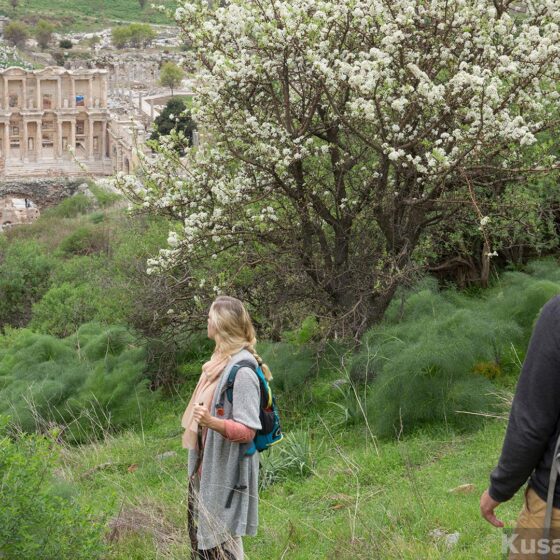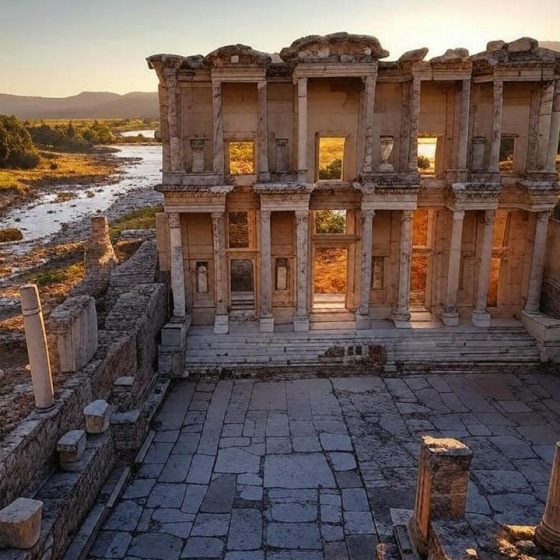Table of Contents Show
Listen up; it’s Alice, and I’ll never forget the night I stumbled into Ephesus, stars scattering across the sky like spilled salt, soft lights pooling over the Library of Celsus’s broken edges. No one shoved past me; no sun blazed down – just a whisper of wind through the ruins and a glow that turned stone into shadows I’d missed before. That hush, broken only by an owl’s call, made Ephesus pulse with life, and now, in 2025, I’m here to tell you why visiting after dark from Kusadasi is pure gold. Let’s start!
Why I Can’t Get Enough of Ephesus at Night
You’ve got to try Ephesus after dark for the calm it drapes over you, a sharp shift from the daytime scramble. Warm glows, updated recently, splash across the Celsus Library, Great Theatre, and Temple of Hadrian, morphing stone into a stage for stories. I’ve perched in the Great Theatre, its 25,000 empty seats staring skyward, picturing Roman shouts, and the silence felt like a secret I’d stumbled upon. Summer’s heat vanishes; a breeze lets me linger, running a torch over the Terrace Houses’ mosaics, their patterns leaping out in shadow. It’s a way to touch Ephesus’s 2,300-year depth up close, far from the noon crush, and I’ve walked away each time with a tighter grip on its past.
How Night Twists Daytime
Ephesus by day is a stunner, but night reshapes it into something quieter, more mine. Under the sunlight, I dodged tour groups on Curetes Street, sun battering marble that singed my feet. After dark, those paths stand empty, harsh rays swapped for a gentle shimmer that picks out arches and statues in soft shapes. The Library of Celsus, already grand, shines like a steady beacon against the dark, its carvings catching light in ways I’d glazed over. Daytime din, guides yelling, cameras snapping—melts into the rustle of leaves and far-off night sounds, letting me catch the stones’ murmur. Access narrows to main sites, but that focus feels personal, and I’ve relished summer’s cool air, post-Kusadasi beach days, as a welcome break.

What Visitors Have Shared
I’ve listened to people who’ve experiences into Ephesus at night, and here’s what they’ve told me:
Sarah, a mum from London, chuckled, “We nipped over after a sweaty afternoon at Ladies Beach. The kids were gobsmacked by the lit ruins—it was like we’d crashed a private show. I couldn’t stop staring at the Celsus Library; it had this quiet, haunting pull.”
Tom, a solo traveller from Manchester, grinned, “I’d tramped Ephesus in daylight, but night turned it wild. No chaos, just me, the stars, and those glowing stones. The Theatre’s hush got under my skin—I hung around until they practically pushed me out.”
Hannah, part of a couple from Bristol, said, “We grabbed a late dolmus from Kusadasi after dinner. The air was sharp, the ruins glowed softly, and it felt like we’d sneaked into history’s private club.”
Tips to Make Your Night Visit Shine
Planning from Kusadasi? Here’s the straight talk: Tours or solo trips run from Kusadasi, with summer 2025 hours likely 6 p.m. to midnight – check schedules near your trip.
Wear solid shoes for uneven ground, pack a small torch for shadowy bits—your phone’s light does the trick—and toss a light jacket in your bag for the evening cool.

Main paths are lit and safe, but shadows deepen off-route; stick to marked paths for ease.
Late dolmuses link to Ephesus, but timings shift. Double-check return schedules, or you might end up asking a local for a lift back, like I did once after missing the last bus.
See also: Luxury Escapes in Kusadasi
Ephesus at night isn’t some overblown gimmick. It’s a real way to see an ancient city without the daytime crush. With extended hours and fresh lighting, it’s more inviting than ever from Kusadasi or Selcuk. Head out after sunset, and you’ll see why it’s worth it. Trust me; it sticks!
Last updated on February 27, 2025



